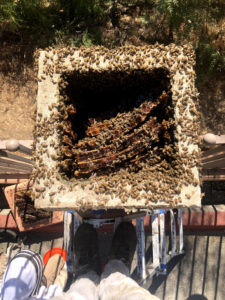Bees Inside a Chimney

So, you think you have a beehive inside your chimney, and you’re not sure what to do. It happens all the time, especially when bees decide to invade a chimney. Although there are many other ways bees can get into your home, through the chimney is one of the most common scenarios. Usually, the first thing you will notice is bees flying in the windows or up near the skylights. You see, when a swarm first invades a home, some of the members of the colony may become disoriented and separated from the rest of the colony. Instead of staying in the swarm cluster, these bees end up lost inside your home. The reason they usually end up near the window is that bees are drawn to the natural light. They head straight for the window in an attempt to get back outside. So, what should you do when bees invade your chimney and are getting inside your home through the fireplace? The first thing you should do is call a bee removal company to remove the swarm or hive. The sooner you call, the more likely that the bee removal professional will be able to remove the bees humanely. The longer you wait, the more likely the bees will build a hive and become more defensive. Defensive hives are much riskier to remove live.
You’ve asked around and searched online, hoping to find a quick and easy way to resolve the bee problem. If this is happening to you, there is a good chance that someone (or some website) is encouraging you to light a fire in order to get the bees out of the chimney. The theory works like this. If you light a fire, the smoke will cause the bees to leave the fireplace on their own. Sounds logical. The problem is, lighting a fire can sometimes make your bee problem worse. Let’s break it down
Sometimes, but not always. “How can that be?” you may ask. After all, lighting a fire seems like a no brainer, right? The smoke will drive away the bees, right? In theory this all sounds good, but in reality, it can sometimes be the worst thing to do. So why is it a bad idea to light a fire in a chimney with bees inside? Let us examine three scenarios when lighting a fire can do more damage than good.
We can’t tell you how many times I hear from our customers that they have lit a fire for days (sometimes over a week) and the bees still return once the fire is out. One customer actually reported to us that he could see the swarm of bees literally hovering in a ball above the chimney, waiting for the fire to subside. For hours he said, the bees hovered and never left until the fire went out. He eventually gave up and called us when he realized there was no way to keep the fire burning around the clock for eternity. In this case, the bees were not going to move easily by just lighting a fire alone.

When there is a fully established Hive Inside.
This means the bees have been inside the chimney long enough to have built a hive. Why is this important? Unlike a swarm or a small undeveloped hive, an established hive has wax, honeycomb, and honey. All three of these things can melt if exposed to heat. Yes, that’s right. If you light a fire, the wax and honey could melt, drip, and cause considerable damage to the chimney. We have even seen cases where the entire hive gets hot and slides down the chimney, into the fireplace.

When The Bees Become Defensive.
When the bees become defensive. It’s important to know that lighting a gas burning fireplace with a bee in a chimney can cause a lot of problems. The main problem is that the bees will often become very agitated and aggressive. Unlike a wood burning fireplace, gas fire does not trick the bees into thinking there is a fire. Instead, the bees become defensive and will sometimes even enter the house in attack mode. If the goal is to drive the bees away, lighting a gas fire will often have the opposite effect.
The answer is sometimes, if the following conditions are present. If the bees have not had a chance to build a hive yet, there are times were lighting a wood burning fire will cause the bees to leave. If, however the bees already built a hive, another swarm may re-infest the same area in the future. This is because bees are attracted to the pheromones inside of hives. The bigger the hive, the quicker it will become re-infested. If, however, you catch the problem early (before there is a hive), the chance of a re-infestation is greatly reduced.
The best thing to do is call a professional who has the proper equipment, knowledge and skills to fix the problem. Need help immediately? Check out our blog on what to do when bees enter your home through your fireplace for tips that will provide temporary relief while you wait for a professional to resolve the problem.
